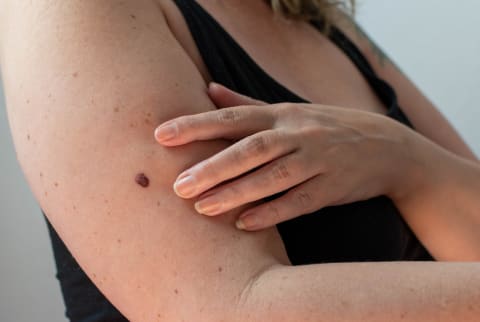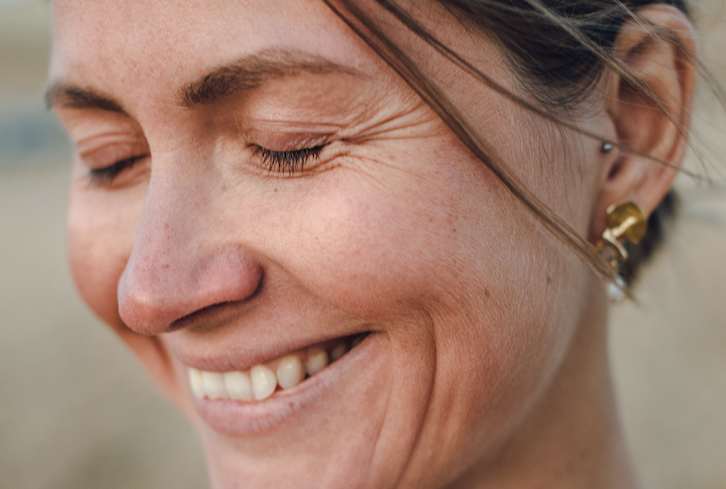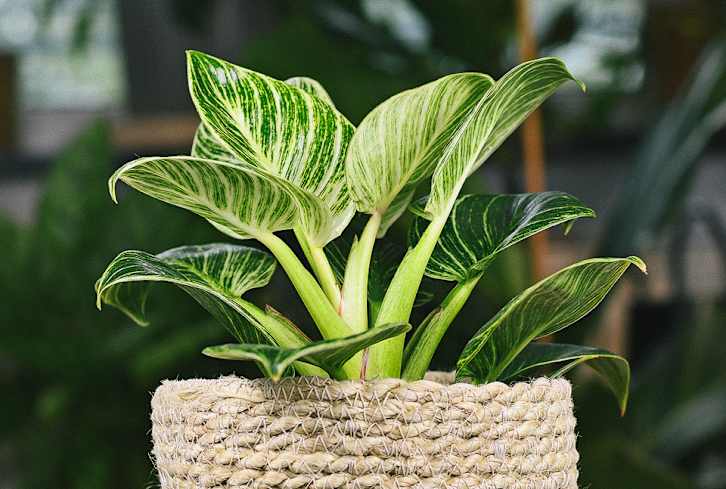Advertisement
Have Bumps On Your Arms? This Surprising Habit Makes KP Worse, Not Better (+ What You Should Do Instead)


Small, flesh-colored or pink pumps on the arms and thighs are an extremely common skin condition. It’s called Keratosis pilaris, or KP, and upwards of 80% of adolescence and 40% of adults experience it. So while it makes lots of folks feel insecure about their skin, it’s certainly not uncommon—chances are, you know several people who also are dealing with this texture issue somewhere on the body.
KP is a genetic trait and is caused by the bui dup of keratin and dead skin cells within the hair follicles1. When packed like this, the hair follicle naturally swells and becomes inflamed—which accounts for the bumps and redness that often comes with KP.
In an attempt to smooth the texture, one of the first actions folks take is to try and scrub it away. And while gentle exfoliation can be helpful, when taken too far, it can actually make your KP worse. Here’s what you need to know about the hidden dangers of trying to scrub KP away.
The tricky balance between exfoliation & KP
Exfoliation is the act of removing excess dead skin cells from the skin’s surface, the stratum corneum. Given KP is caused by dead skin cell buildup, in theory, this sounds like a simple solution, no? And it is true that exfoliation can be hugely beneficial for smoothing skin texture, declogging pores, and removing buildup.
The problem arises when the exfoliation is too harsh or too frequent. Over-exfoliation or aggressive exfoliation can trigger irritation. This is because if you remove too much of the stratum corneum, it actually comprises the skin barrier. This damage, although completely unintentional, causes the skin to enter an inflamed state—thereby worsening the KP and any other inflammatory skin conditions.
According to derms, it’s vital to find that exfoliation sweet spot—and when in doubt, error on the side of caution.
"The most important tip is that 'less is more.' You want to exfoliate just enough to increase cell turnover and reveal fresh new skin," says Ife Rodney, M.D., a board-certified dermatologist and founder of Eternal Dermatology about how often you should exfoliate. "But be sure to not scratch or damage your skin by overusing these devices or products."
The exact cadence will differ from person to person, but the most ideal range is 1 to 3 times a week.
How to manage KP without triggering inflammation & making it worse
KP is a chronic skin condition—meaning it’s something that needs to be managed day-to-day with the proper skin care steps.
Use an exfoliating body wash 1-3 times a week
The first step is to find how much exfoliation is right for you, and be mindful to not overdo it. A gentle body wash that’s infused with a chemical exfoliator can be a great option as it’s a wash off product. (Wash off products inherently has less contact with the skin, so less time to trigger irritation.)
"An acne body wash containing AHAs or BHAs would be helpful for managing KP," says board-certified dermatologist Lisa Airan, M.D., who says that a mild 2% salicylic acid cleanser can help gently remove buildup and excess skin cells.
And while scrubs aren’t off limits, the granular nature of the product can be irritating for sensitive skin types.
Hydrate daily with soothing topicals.
Applying a body lotion or oil daily will help keep the skin strong and reduce inflammation. Look for ingredients that not only hydrate the skin, but can fortify the moisture barrier and help neutralize oxidative stress.
For example, mindbodygreen’s postbiotic body lotion. The body hydrator is a blend of coconut oil, shea butter, aloe vera, oat oil, and moringa seed oil as a conditioning base. These rich moisturizers offer loads of humectants, emollients, fatty acids, and lipids to cushion the skin's moisture barrier, resulting in lasting hydration.
Additionally, the formula folds in some high-powered antioxidants (a stable coenzyme q10 and a fruit complex) to help the skin fight off free radicals. These antioxidants also offer aesthetic benefits, like brightened tone, reduced irritation, and smoothness. But the stars of the show are the biotic ingredients, the pre- and postbiotics. These support your body's crucial skin microbiome—which in turn can help reduce skin irritation, improve epidermal framework reconstruction, and overall improve hydration levels.
If oils are more your speed, mindbodygreen’s dry body oil. It's an edited-down, simple blend using only high-quality oils. It's a mix of sunflower, organic safflower, squalane, prickly pear, and vitamin E oils. These are full of skin-supporting nutrients to nurture the barrier, provide antioxidant properties, and feed the skin lipids.
Address lifestyle factors
While KP is genetic, there’s also lifestyle factors that can influence its appearance. Essentially you have to be genetically predisposed to the condition to develop it, and if you are, certain diets and habits can make it worse.
For example, inflammatory diets can increase inflammation in the body as a whole. This can oftentimes be seen in the skin in the form of flare-ups. (For example, eating a high-glycemic index diet can lead to worsening acne2.) For KP, some derms believe there’s a connection, although more research is needed.
"What I'm beginning to suspect is that this is a low-grade inflammation in the body that's showing up in the hair follicle," says holistic dermatologist Alan Dattner, M.D., adding that increasing your intake of certain nutrients and eliminating certain foods that contribute to inflammation may help manage KP.
The takeaway
KP is a very normal deviation of the skin. And why we don’t fully understand the underlying triggers, we know that managing inflammation as a whole can help improve the appearance. It’s very important to remember, though, that KP is all about regular management.
-v1646695196476.jpg?1148x800)


















